Agave Spirits - Part IV: Family Heritage
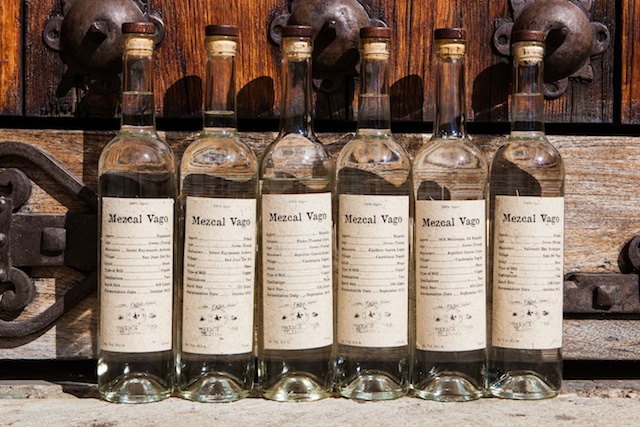
(all photos courtesy of Mezcal Vago and Joanna B. Pinneo)
I can't tell you how many great products we've "discovered" at K&L simply because the producer took the time to drive by the store and solicit us with a cold call. It's not a practice we generally appreciate, but every now and again it works out. When Judah Kuper came by the store around Christmas time it probably wasn't the best moment for us to chat (me being buried under a deluge of whiskey orders), but we made some time and he told me his story. Then he let me taste his mezcales. I remember saying to him before he left, "I will buy as many bottles of these as you can get me." Over the next few weeks Judah would finalize a deal with an importer, set up California distribution, and get his Vago mezcales ready for us to purchase. Starting tomorrow we'll have the complete line available at K&L.
So what's the deal?
Judah is a surfer and one time while on a surfing trip along the Oaxacan coast, he met a lovely Oaxacan lady who was part of a local mezcal-producing family. He was instantly smitten. Sometime later, he found himself married to this lovely Oaxacan lady and developing an appreciation for her family's traditional distillates. "You know we could probably market these and sell them in the U.S." he said to her one day. Judah had just as much saavy with the computer as he did with the surfboard, so he designed a label (made from 100% agave paper) and created a name for the brand. In the end, it's a story we're very familiar with in the spirits industry. Boy meets girl. Boy discovers family legacy. Boy tells romantic story of the family legacy. Boy creates fancy label that sells that romantic story. I've heard this tale before from many a craft producer. The difference with the story of Mezcal Vago is that it ends with a line-up of incredible booze. To put it shortly, the mezcales from Judah's Oaxacan in-laws are among the most exciting and dynamic we've ever tasted at K&L. We're very excited about their imminent arrival.
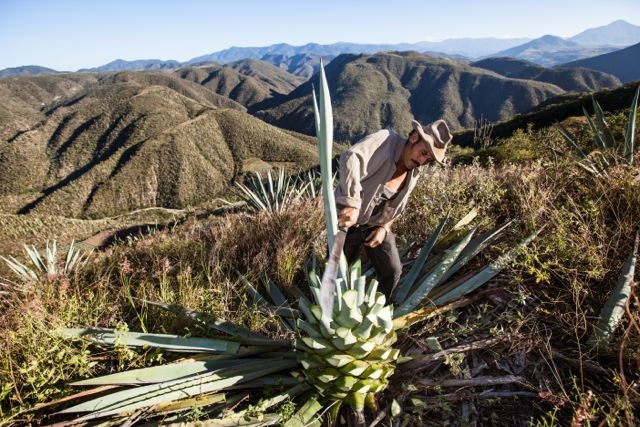
This is Aquilino García López, Judah's father-in-law, harvesting an agave plant on his property deep within the Oaxacan mountains (about a three-hour drive from Oaxaca City). Aquilino has never produced
mezcal commercially, rather only for his own consumption and for neighbors living nearby. He cultivates his own espadín and mexicano agave, then forages for cuixe and tobalá to make special distillates from those wild-growing species. He represents the fifth generation of distillers in his family and does all of the work himself. That work starts with a machete.
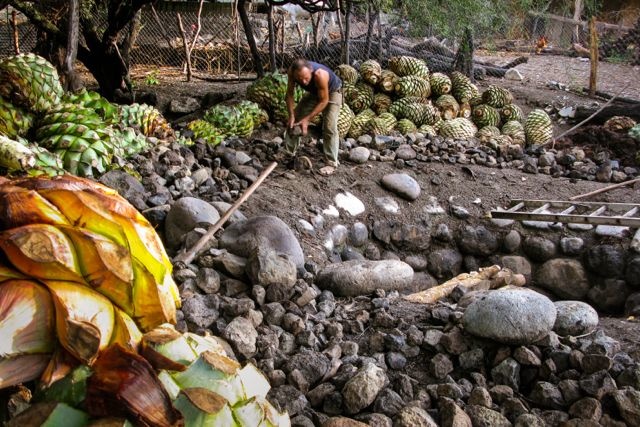
Once the agave has been harvested and the leaves and outer layer removed, the piñas are roasted in an underground pit. Aquilino makes field blends of mezcal as well, sometimes combining different species together during the cook, fermenting them and distilling together as well.
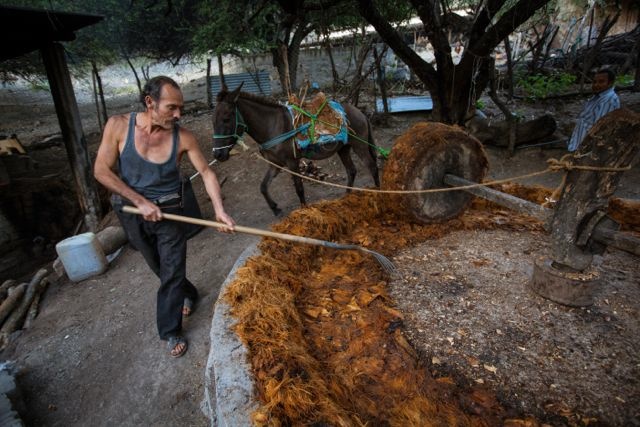
Once the piñas are roasted they're crushed with a stone tahona and prepped for fermentation in 1000 liter wooden vats made from pine. Only the agave and water are used as the natural yeasts in the air begin the fermentation process naturally.
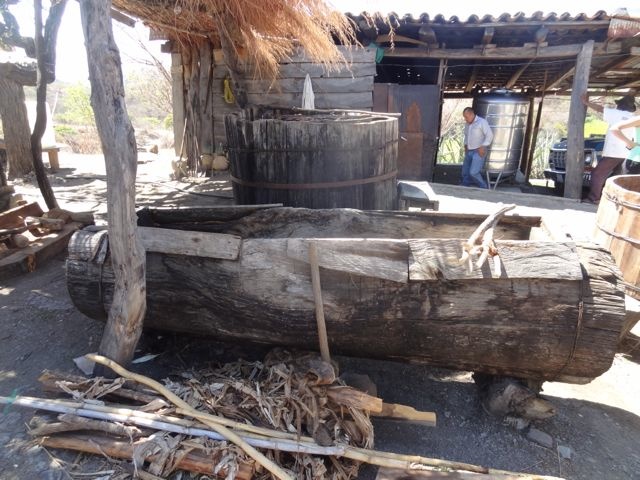
Of the six mezcales currently available from Vago, four of them are distilled by Aquilino. The other two are made by Salomón Rey Rodriguez, a family member known as "Uncle Rey." His property is in Sola de
Vega -- the most famous spot in the world for agave tobalá. Like Aliquino, he is not a commercial producer, so his releases for Vago mark the first time his mezcales have been sold commercially. He uses the above trunk of a pine tree, hollowed out in the shape of a canoe, for fermenting his agave. It's been in use for more than ninety years!
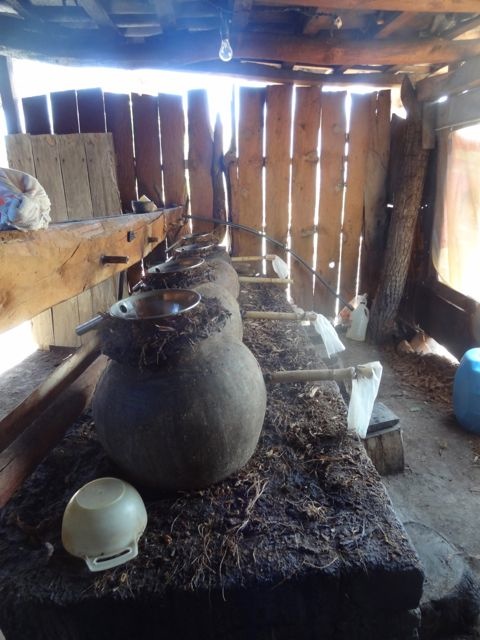
This is where things get really interesting. For distillation, Uncle Rey uses a series of fifty liter clay pots. According to Judah, "Each pair of pots shares a fire. The stills are made of stacks of two pots: one that holds the mash and has an open top, and another with an open bottom that rests on top of the first one. On the top pot there is an upside-down stainless steel bowl that water continually runs in and out of. When the heat from the mash rises and hits the cool top created by the water, condensation occurs. An agave leaf works as a large spoon to catch the dripping condensation (Mezcal) and runs into a piece of bamboo and into the collection container. This whole process is really laborious and takes probably 4 times the effort of a copper still and stone tahona process."
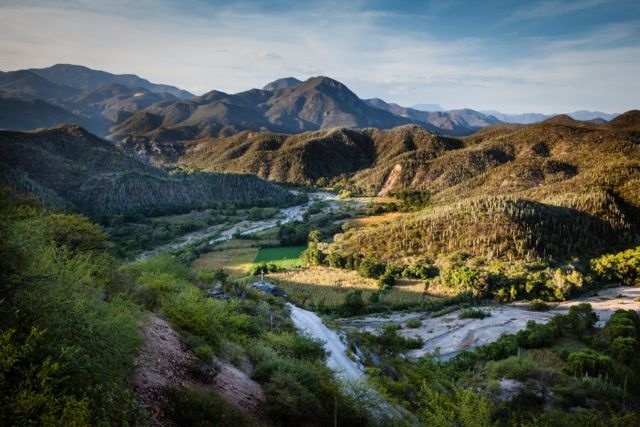
Personally, I am on a quest to help explain to customers why agave spirits are more than just tasty ingredients in a margarita. Much like the Vinos de Agave series from Wahaka I wrote about earlier, the Vago mezcales represent a portfolio of agave distillates, all completely different from the next, with clear explanations as to which agave they were made from, how they were made, and why they taste the way they do. They have character, depth, complexity, a hell of a romantic story, and they showcase the potential for terroir in the spirits world more than any whiskey could ever hope to. More importantly, they're accessible, reasonably-priced, and relatively-unknown, which will make it easier for you to try them.
I'll, of course, post tasting notes and the full array of selections once these arrive. We think they're going to be very, very popular. Stay tuned.
-David Driscoll
